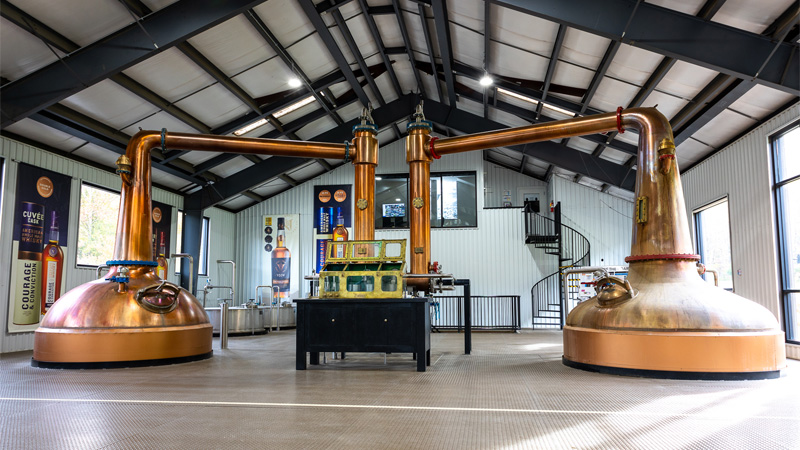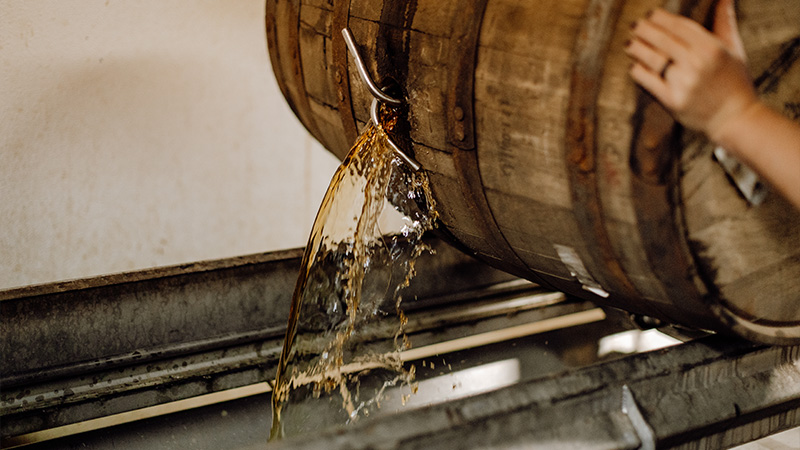Unless it’s bottled at barrel strength, all whiskey contains water that’s added after it’s matured to bring it to a specific proof. Most distillers calculate by weight or volume how much water is needed to bring a whiskey to their desired final ABV, and just add it to the tank, perhaps waiting a day or two before bottling. But a cadre of small producers is taking a more deliberate approach to proofing, slowing it down, and adding the water in small increments over a long period of time.
“It’s very similar to making a stew or a curry — it allows an integration of flavor,” says Nora Ganley-Roper, co-founder of Lost Lantern Whiskey, adding that the technique imparts a more gentle mouthfeel as well. Lost Lantern proofed its first-edition American Vatted Malt, a blend of whiskeys from six distilleries, from a barrel strength of over 60 percent down to 52.5 percent ABV over three months. “That was especially important for us because we’re blenders and because we’re working with quite different whiskeys from all across the country, as opposed to different barrels from within the same distillery,” says Adam Polonski, Ganley-Roper’s partner and Lost Lantern co-founder. “When we first poured everything together, it was a little jagged and the flavors, as we slowly brought it down to proof, came together really nicely.”
This technique, called slow proofing, slow reduction, or slow cutting, avoids the more dramatic chemical reactions that take place when water and alcohol meet, which heat up the solution and damage subtle flavor compounds. After all the effort distillers expend to create those flavors earlier in the production process, a less careful proofing down can seem like a waste. “If it’s an aggressive, big addition of water, it can destroy some of the really delicate, beautiful esters that we spent days developing during fermentation. So we didn’t want to mask or lose any of that,” says Amanda Beckwith, lead blender at Virginia Distillery Co. The distillery takes at least three months to proof down each batch of its Courage & Conviction single malt to the final bottling strength of 46 percent ABV.
Don’t miss a drop!
Get the latest in beer, wine, and cocktail culture sent straight to your inbox.

Borrowed From Brandy
Virginia Distillery Co. and Lost Lantern both learned about slow proofing from Nancy Fraley, a blender, consultant, and “nose” who works with whiskey producers across the country. (Virginia Distillery Co. has even named one of its Courage & Conviction batches after her.) Before entering the whiskey world, Fraley worked with legendary brandy distiller Hubert Germain-Robin, and learned about slow proofing from him. “It’s a technique that’s never been used [for whiskey],” Fraley says. “Nobody’s even heard of it outside of the brandy world.”
But brandy distillers have been slow proofing for centuries. “For brandies that have, in particular, been distilled on the lees [dead yeast], they have a lot of fat,” Fraley explains. “If you try and add water to that from barrel to bottling strength too fast, you’re just going to end up with a soapy mess.” The soap flavor comes from saponification, a chemical reaction in which a fatty acid breaks down.
Whiskeys like bourbon, Fraley says, have less fat than brandy and are less likely to saponify, but still benefit from slow proofing. “If you reduce it slowly, you’re going to end up with a product that has overall a better mouthfeel,” she says. “You’re going to find a better integration of water with alcohol and oak. Flavors are going to be a little bit more clearly defined.”
At least eight or nine distillers and blenders count themselves among Fraley’s followers, including Greg Metze, the longtime MGP master distiller who now makes Old Elk whiskey. Metze slow proofs his bourbon, rye, and wheat whiskeys over a week and a half. “For me, it just adds to the balance and integrity of the product,” he says. “In woodworking terms, it would be rounding the edges off a tabletop. So rather than having a square sharp edge, the slow-cut proofing process rounds that edge and just smooths things out.”

Game-Changing Technique
If slow proofing makes such a meaningful difference, why aren’t more distilleries doing it? For one thing, all those extra tanks take up space, and space is expensive. So is the labor required for painstakingly adding precise amounts of water week after week. It’s much less feasible for established distilleries with larger economies of scale than for smaller, new ones, although those producers that have incorporated the process from the beginning, like Cognac houses, manage it successfully.
But to slow-proof disciples, the added time and expense are worth it. “For a blending house, especially if you’re working with a wide variety of whiskeys, it’s essential,” Polonski says. “Our American Vatted Malt would not be the way that it is if we hadn’t slow proofed it. These flavors really needed some time to get to know each other before they got bottled.” For Fraley’s clients, slow proofing is a game changer. “With all the distilleries I work with, there’s no going back,” she says.
Though simply slow proofing has a significant impact on a whiskey’s palate, Fraley also sometimes employs “petite eau” to build further flavors in a finished product. Again borrowed from Cognac, the technique adds mature whiskey to water — slowly and incrementally — and ages the solution in a barrel. After months or years, the liquid is used to slow proof a whiskey.
Because water-soluble oak compounds are different from alcohol-soluble ones, Fraley says, “you’re essentially getting all these other flavors, a lot more wood sugars, and things from the oak that you wouldn’t get ordinarily just by using ordinary water.” Ironroot Republic, J. Henry & Sons, Still Austin Whiskey Co., Wyoming Whiskey, and Sonoma County Distilling Co. all have used petite eau for some of their whiskeys. Occasionally a distillery might even add water directly to a barrel of whiskey as it matures, combining the two techniques in one fell swoop.
An unknowing drinker might never notice that their whiskey was proofed in one way or another, but the effect of slow proofing is detectable. Metze suggests trying a home experiment with 50 milliliters of high-proof vodka. “Put in, say, 10 milliliters of water, and the glass will warm up in your hand a little bit,” he says. “It’s not dramatic but it is noticeable.”